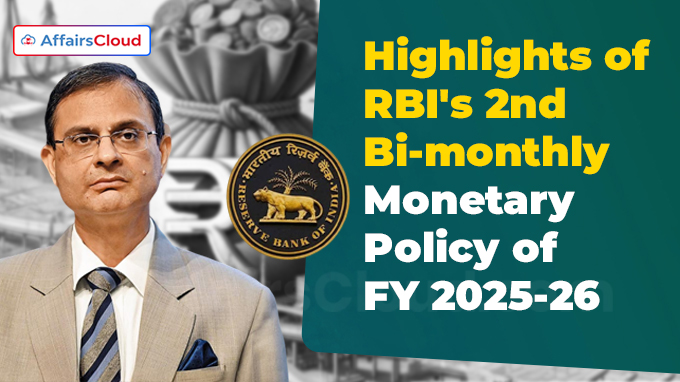 The Reserve Bank of India conducted the 55th and 2nd Bi-monthly Monetary Policy Committee Meeting (MPC) of Financial Year (FY) 2025-26 from June 4 to 6, 2025 under the chairmanship of Shri Sanjay Malhotra, Governor, Reserve Bank of India (RBI).
The Reserve Bank of India conducted the 55th and 2nd Bi-monthly Monetary Policy Committee Meeting (MPC) of Financial Year (FY) 2025-26 from June 4 to 6, 2025 under the chairmanship of Shri Sanjay Malhotra, Governor, Reserve Bank of India (RBI).
- The meeting was attended by the MPC members Dr. Nagesh Kumar, Shri Saugata Bhattacharya, Prof. Ram Singh, Dr. Poonam Gupta and Dr. Rajiv Ranjan.
RBI retains India’s growth forecast at 6.5%:
i.The committee has projected the Gross Domestic Product (GDP) for Financial Year 2025-26 (FY26) to be 6.5%.
- The projection for FY26 for Quarter 1 (Q1: April –June 2025) at 6.5%; Q2 (July – September 2025) at 6.7%; Q3 (October – December 2025) at 6.6% and Q4 (January – March 2026) at 6.3%.
RBI cuts repo rate by 50 bps to 5.5%, changes policy stance to neutral:
i.The MPC voted to reduce the policy repo rate by 50 basis points (bps) to 5.50% with immediate effect and changes policy stance to neutral.
ii.Consequently, the standing deposit facility (SDF) rate under the liquidity adjustment facility (LAF) shall stand adjusted to 5.25 % and the marginal standing facility (MSF) rate and the Bank Rate to 5.75 %.
iii.After cutting the policy repo rate by 100 bps in a short span since February 2025, the scope for further monetary easing to support growth has become quite limited under current conditions.
• Therefore, the MPC has decided to shift its stance from accommodative to neutral.
iv.The committee has decided to reduce the cash reserve ratio (CRR) by 100 bps to 3.0 % of net demand and time liabilities (NDTL).
- This reduction will be carried out in four equal tranches of 25 bps each with effect from the fortnights beginning September 6, October 4, November 1 and November 29, 2025.
RBI’s Policy Rate:
| Category | Rate |
|---|---|
| Repo Rate | 5.50% |
| Reverse Repo Rate | 3.35% |
| SDF | 5.25% |
| MSF | 5.75% |
| Cash Reserve Ratio | 4.00% |
| Statutory Liquidity Ratio | 18.00% |
| Bank Rate | 5.75% |
CPI inflation for FY26 revised to 3.7% versus 4% earlier:
The medium-term target for consumer price index (CPI) inflation of 4% within a band of +/- 2 %.
i.The committee revised the CPI inflation projection for the FY26 at 3.7% from 4%.
- The CPI inflation projection for Q1 at 2.9%, Q2 at 3.4%, Q3 at 3.9% and Q4 at 4.4%.
MPC rate cut impact on home loans:
i.The latest 50 bps cut is expected to significantly reduce home loan interest rates and revive housing demand, especially in the mid- and affordable segments.
- If all the three repo rate cuts effected this year are combined, the cumulative decrease in rate comes to 100 bps.
- Based on the total 100 bps cuts, the monthly benefit on home loan EMIs for borrowers with Rs 50 lakh loan for a 20-year tenure at an interest rate of 8% reaches over Rs 3,000.
RBI to raise gold lending LTV to 85% for loans under Rs. 2.5 lakh:
Inorder to improve access to formal credit for rural and semi-urban borrowers, the Loan-to-Value (LTV) cap for small-ticket gold loans i.e. loan under Rs.2.5 lakh has been raised to 85% from 75%.
- Also borrowers are allowed to submit self-declare gold ownership in the absence of purchase invoices.
Non-gold imports posted double digit growth:
i.Non-oil, non-gold imports posted a double-digit growth, reflecting buoyant domestic demand conditions.
- While, services exports continue on a strong growth trajectory.
Gross FDI increased 14% in FY25:
i.Gross foreign direct investment (FDI) inflows remained strong, rising by around 14 % to USD 81.0 billion in 2024-25 from USD 71.3 billion a year ago.
- However, net FDI inflows moderated to USD 0.4 billion in 2024-25 from USD 10.1 billion a year ago.
ii.Foreign portfolio investment (FPI) to India dropped sharply to USD 1.7 billion, as foreign portfolio investors booked profits in equities.
India’s forex reserves sufficient to meet 11 months of imports:
i.As on May 30, 2025, India’s foreign exchange reserves stood at USD 691.5 billion.
- These are sufficient to fund more than 11 months of goods imports and about 96% of external debt outstanding.
RBI’s policy resets bond markets, signals deeper yield compression ahead
i.Bond yields are significantly affected by monetary policy—specifically, the course of interest rates.
- When the interest rate falls, the price of the bond rises and the bond yield falls.
ii.The benchmark 10-year G-sec yield, which closed May at 6.29 %, dropped 7 bps month-on-month and is now expected to trade in a 6.15–6.25 % band in June.
- The 5-year segment has already priced in this easing aggressively. The 6.75 % 2029 bond yield has declined by 80 bps since March.
- Given the RBI’s neutral stance, the 10-Year segment is poised for further compression towards 6.00 per cent over the next quarter.
RBI lowers qualifying asset criteria for NBFC-MFIs to 60% from 75%
i.The RBI has reduced the qualifying asset threshold for non-banking financial companies – microfinance institutions (NBFC-MFIs) to 60% from 75%, in a boost to the industry.
ii.Qualifying assets of NBFC-MFIs shall constitute a minimum of 60% of the total assets (netted off by intangible assets), on an ongoing basis.
- If an NBFC-MFI fails to maintain the qualifying assets as per the threshold for four consecutive quarters, it shall approach the RBI with a remediation plan for taking a view in the matter.
RBI restricts lending against gold bullion, issues harmonised guidelines for gold, silver loans
i.The RBI has issued revised direction on – “Lending against Gold and Silver Collateral Directions,2025”. The objectives behind these directions are:
- To put in place a harmonised regulatory framework for such loans applicable across various Regulated Entities (REs);
- Address the concerns observed relating to some of the lending practices being followed and provide necessary clarity on certain aspects; and
- Strengthen the conduct-related aspects.
ii.The RBI has now prohibited lending against primary gold assets such as gold bullion, citing broader concerns around financial stability and the speculative, non-productive nature of such investments.
- The RBI has clarified that REs may continue to offer loans backed by gold jewellery, ornaments, or coins, which are considered practical avenues for borrowers seeking short-term financing.
- Past regulations on lending secured by silver were also shaped by similar concerns.
Private banks see steepest fall in credit growth to 9.5% in FY25
i.According to the data released by the RBI, the credit growth decelerated across all bank groups in FY 2024-25.
- Private banks had the steepest decline, of 9.5%, in March after a sustained credit growth of above 15% for the preceding three years.
No plans to raise foreign ownership cap in banks beyond 15%
The RBI governor confirmed that there is no move to increase foreign ownership limits beyond 15% in a single institution at present
- He stated that 15% foreign ownership is permitted for non-residents, this limit may be exceeded in specific cases based on individual assessments.
Important Definitions:
Repo rate: It is the interest rate at which the Reserve Bank of India (RBI) lends money to commercial banks for short-term needs, against government securities.
Reverse Repo rate: It is the interest rate at which the Reserve Bank of India (RBI) borrows money from commercial banks, usually for short durations.
Cash Reserve Ratio: It is the percentage of a bank’s total deposits that it must be kept as reserves with the RBI in the form of cash form.
Statutory Liquidity Ratio: It is the minimum percentage of a bank’s net demand and time liabilities (NDTL) that it must maintain in the form of liquid assets — like cash, gold, or government-approved securities.
Qualifying Asset: The definition of qualifying asset is aligned with the definition of ‘microfinance loans’.
- A microfinance loan is defined as a collateral-free loan given to a household having annual household income up to Rs. 3 lakh.




